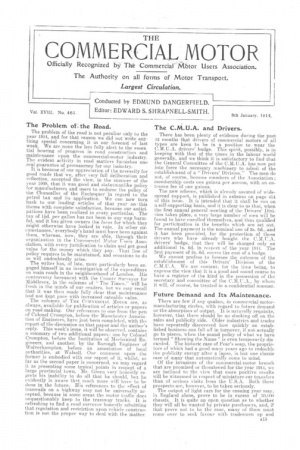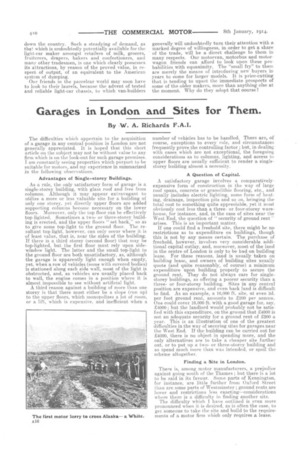The Problem of the Road.
Page 1

Page 2

If you've noticed an error in this article please click here to report it so we can fix it.
The problem of the road is not peculiar only to the year 1914, and for that reason we did not write any thing special concerning it in our forecast of last week. We are none the less fully alert to the essential bearing of progress in road construction and 'maintenance upon the commercial-motor industry.
The evident activity in road matters furnishes one real guarantee of permanency for our industry. It is because of our appreciation of the necessity for good roads that. we., after very full deliberation and reflection, accepted the view, in the summer of the year 1909, that it was good and statesmanlike policy for manufacturers and users to endorse the policy of the Chancellor of the Exchequer in regard to the petrol tax and its application. We can now turn back to our leading articles of that year on this theme with complete satisfaction, because our anticipations have been realized in every particular,. The tax of lid. per gallon has not been in any way, harmful, and it has given owners the locus for which they might otherwise have looked in vain. In other circumstances,' everybody's hand must have been against them, whereas, now, they are able, through their organization in the Commercial Motor -Users Asso:elation, with every justification to claim and get good value for the money which they pay. That line of
• policy requires to be maintained, and occasions to do so will undoubtedly arise.
The writer has, of late, more particularly been engaged himself in an investigation of the expenditure on main roads in the neighbourhood of London. His controversy hereanent with the COUDI.V Surveyor for 'Middlesex, in the columns of "The Times," will be fresh in the minds of our readers, but. we may recall that it was then made fully clear that maintenance had not kept pace with increased rateable, value.
The columns of THE COATIVIERCIAL Moron are, as .always, available for publication of articles or papers on road-making. Our references to one from, the pen of Colonel Crompton, before the Manchester Association of Engineers, have just been completed, with the. report of the discussion on that paper and the author's reply. This week's issue, it will be observed, contains a summary of two additional papers : one by Colonel Crompton, before the institution of Mechanical Engineers, and another, by the Borough Engineer of Wolverhampton, before an association of local authorities, at Walsall. Our comment. upon • the former is embodied with our report of it, whilst, so far as the second paper is concerned, we may regard it as presenting some typical points in respeet of a large provincial town. Mr. Green very honestly regrets his inability to do all that he should, but he evidently is aware that much more. will have to be done in the future. His references to the effect of trarnrails on a highway may not be universally accepted, because in some areas the motor traffic does unquestionably keep to the tramway tracks. It is refreshing to find a road surveyor lioneetIy admitting that regulation and restriction upon vehicle construction is not the proper way to deal with the matter, The C.M.U.A. and Drivers.
There has been plenty of evidence during the past 12 months that drivers of commercial motors of all types are keen to be in a position to wear the C.M.U.A. drivers' badge. This spirit, possibly, is in keeping with that of the times in the labour world generally, and we think it is satisfactory to find that the General Committee of the C.M.U.A. has now put into force the necessary machinery to admit of the establishment of a " Drivers' Division." The men do not, of course, become members of the Association ; membership costs one guinea per annum, with an entrance fee of one guinea. The new scheme, which is already assured of widespread support, is published in extenso on page 414 of this issue. It is intended that it, shall be run on a self-Supporting basis, and it is clear to us that, when the fthst annual general meeting of the Drivers' Division takes price, a very large number of men will be found to have. enrolled themselves, and thus qualified for participation in the. benefits which are set out. The annual payment is the nominal one of 2s. 6d., and it has been provided, for the protection of those drivers who have already bought the C.M.U.A. drivers' badge, that they will be charged only an additional Is. 6d. in respect of the year 1914. The first payment of 2s. 6d. covers the cost of a badge.
We cannot profess to foresee the outcome of the establishment of this Drivers' Division of the C.M.U.A. We are content, for the time being, to express the view that it is a good and sound course to have a register of the kind in the possession of the secretary and committee of the C.M.U.A., by whom it will, of course, be treated in a confidential manner.
Future Demand and Its Maintenance.
There are few if any qualms, in commercial-motormanufacturing circles, with regard to future demand or the absorption of output. It is naturally requisite, however, that there should be no slacking off on the sales and publicity side. Older industries and trades have repeatedly discovered how quickly an established business can fall off in turnover, if not actually go to pieces, when the sound policy of what we have termed" Showing the Name " is even temporarily discarded. The historic case of Year's soap, the proprietors of which had a good many years ago to redouble the publicity energy after a lapse, is but one classic ease of many that automatically come to mind. Of the intasions of the commercial-motor branch that are promised or threatened for the year 1914, we are inclined to the view that more positive results will be witnessed in respect of miniature-car transfers than of serious visits from the U.S.A. Both these prospects are, however, to be taken seriously. The output of light cars for the ensuing year may, in England alone, prove to be in excess of :10,0txi chassis. It is quite an open question as to whether they will all be wanted by private purchasers, and, if that prove not to be the ease,. many of them must come over to seek favour with tradesmen up and down the country. Such a steadying of demand, as that which is undoubtedly potentially available for the light-car maker amongst retailers of milk, grocers, fruiterers, drapers, bakers and confectioners, and many other tradesmen, is one which clearly possesses its attractions, by reason of the proved value, in respect of output, of an equivalent to the American system of dumping.
Our friends in the parcelcar world may soon have to look to their laurels, because the advent of tested and reliable light-car chassis, to which van-builders
generally will undoubtedly turn their attention with a, marked degree of willingness, in order to get a share of the trade, will be a direct challenge to them in many respects. Our motorvan, motorbus and motorwagon friends can afford to look upon these probabilities with equanimity. The "small fry" to them are merely the means of introducing new buyers in years to come for larger models. It is price-cuttingthat is tending to upset the immediate prospects of some of the older makers, more than anything else at the moment. Why do they adopt that course ?




















